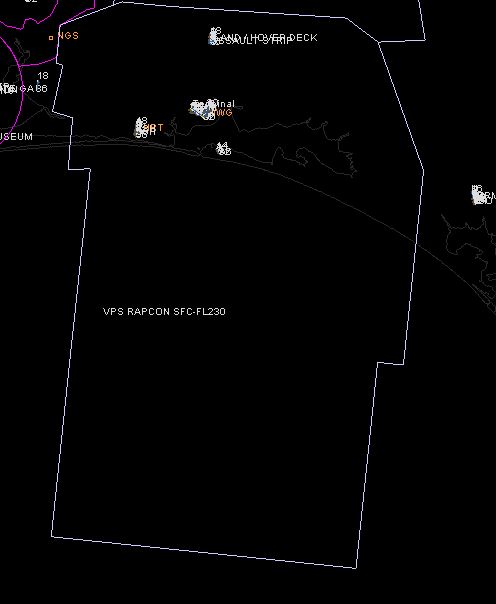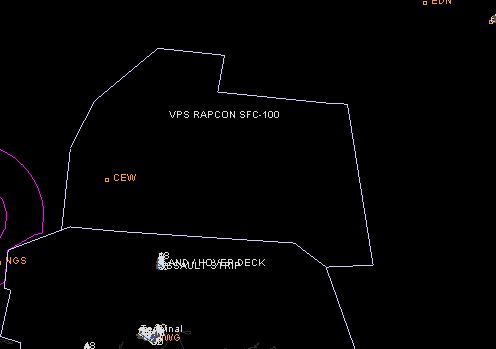VPS SOP
Area Information
| ICAO Code | Airport Name | Airspace | IFR Beacon Codes | VFR Beacon Codes |
|---|---|---|---|---|
| KVPS | Eglin Air Force Base/Destin-Fort Walton Beach Airport | D | 2701-2777 | 2701-2777 |
Purpose:
This document prescribes the procedures to be utilized for providing air traffic control services at the Columbia Air Traffic Control Tower (CAE ATCT) and TRACON. The procedures described herein are supplemental to the Jacksonville ARTCC Facility Operating Guidelines and FAA Order JO 7110.65, as well as any published FAA guidelines or procedures.
Distribution:
This order is distributed to all Jacksonville ARTCC personnel.
Operational Positions
| Position | Radio Name | Callsign | Relief Callsign | Symbol | Frequency |
|---|---|---|---|---|---|
| Clearance Delivery | Eglin Clearance Delivery | VPS_DEL | VPS_1_DEL | 1VD | 127.700 |
| Ground | Eglin Ground | VPS_GND | VPS_1_GND | 1VG | 121.800 |
| Tower | Eglin Tower | VPS_TWR | VPS_1_TWR | 1VT | 118.200 |
| Position | Sector Name | Callsign | Relief Callsign | Symbol | Frequency |
|---|---|---|---|---|---|
| RS | Radar South | VPS_S_APP | VPS_1S_APP | 1VS | 132.100 |
| RF | Radar North | VPS_N_APP | VPS_1N_APP | 1VN | 125.100 |
Sector in Red is the primary sector.
ATCT Information
IFR Departure Instructions
Clearance/Route
All Aircraft shall be "Cleared as filed" unless a route amend is necessary. All routes must comply with LOA-approved standards. Aircraft unable to accept preferred route require coordination between all affected facilities.
Altitude
Instruct all pilots to maintain 3,000 feet and to expect filed cruise altitude (If higher) ten minutes after departure. All filed cruise altitudes must be checked for validity for the direction of flight and/or LOAs.
Departure Frequency
The Primary Departure Frequency is VPS_S_APP on 132.100. Updates to the Departure Frequency will be given by the RAPCON controller.
Transponder
All departing aircraft shall be assigned a trasnponder code between 2701-2777.
VFR Departure Instructions
Altitude
If Aircraft is not remaining in the pattern, issue the instruction "Maintain VFR below 3,000 feet".
Departure Frequency
VFR aircraft not remaining within the pattern shall be given a departure frequency. The Primary Departure Frequency is VPS_S_APP on 132.100. Updates to the Departure Frequency will be given by the RAPCON controller.
Transponder
All VFR aircraft not remaining in the pattern requesting flight following services shall be assigned a transponder code between 2701-2777.
Pushback and Startup
GC does not authorize pushbacks or startups unless the aircraft
pushing back will enter a controlled area during pushback.
- In these instances, aircraft should be instructed “Push and start approved, push tail facing (direction).” The direction should keep the aircraft pointed in the direction the aircraft will taxi.
- If the pilot calls to push, and no controlled area will be penetrated, simply advise the pilot “Push and start at pilot's discretion.”
Intersection Departure
GC must advise LC of all intersection departures verbally or through the chatbox.
ATIS
GC shall ensure pilots have the current ATIS prior to the aircraft being handed off to LC.
Active Runway Operations
GC must transfer communications to LC if an aircraft is to operate on an active runway.
Handoffs
GC shall instruct aircraft to “Contact Eglin Tower 118.200” unless otherwise agreed upon by LC. LC can request pilot monitor the frequency instead of contacting.
Area of Responsiblity
LC has responsibility for the lateral VPS Class D airspace from surface up to and including 2,600 feet.
For pattern work aircraft, LC airspace extends 4nm from the geographic center of VPS from surface up to and including 2,100 feet.
Active Runway Selection
The active runway shall be determined based on wind and known factors that may affect the safety of takeoff/landing operations. Runway 19 is designated as the calm wind runway
Exceptions
Runway 12/30 are the primary runways for VFR/overhead runway, approach end arrestment runway, simulated flameout approaches.
Departure Procedures
LC will provide separation for aircraft in the LC airspace. LC shall provide initial radar separation between successive departures. When automatic departures are in effect, IFR jet/turbojet departures shall be released on runway heading climbing to 3,000 feet.
Arrival Procedures
LC shall be responsible for separation of all arrival aircraft that have
been handed off by RAPCON from all departing aircraft still under LC
jurisdiction
Communication transfer must be completed prior to five nautical miles
from the runway.
Practice Instrument Approaches: Issue special instructions as verbally coordinated with the
RAPCON.
LC shall NOT change the approach sequence without coordination.
Go Around/unplanned Missed Approach
Issue the following instructions:
Runway 1: Fly Runway Heading, Cross Departure End Of The Runway At Or Below 1000 Feet, Climb And Maintain 3,000, Then Turn Right Heading 110.
Runway 12: Fly Runway Heading, Cross Departure End Of The Runway At Or Below 1000 Feet, Climb And Maintain 4,000 Thousand Feet, At 3 DME Turn Left Heading 030.
Runway 19: Fly Runway Heading, Cross Departure End Of The Runway At Or Below 1000 Feet, Turn Right Heading 270, Climb And Maintain 3,000.
Runway 30:Fly Runway Heading, Cross Departure End Of The Runway At Or Below 1000 Feet, Turn Left Heading 180, Climb And Maintain 3,000.
Automatic Release
LC is authorized automatic releases from the RAPCON controller so long as the aircraft departs on the pre-coordinated active departing runway(s) on approved departure headings
In order for automatic releases to be authorized, procedures in this document shall be followed.
Departure releases must be obtained if automatic releases are suspended by TRACON.
Visual Tower
Eglin ATCT is a visual/VFR tower and shall
not initiate or accept any radar handoffs and shall not initiate control/start track on any target.
ATIS
LC shall manage the ATIS for KVPS.
VFR Overhead Pattern Protection
When aircraft are operating in the VFR overhead pattern, all departures from VPS shall maintain at or below 1,000 ft MSL until the departure end of the runway to protect the VFR overhead pattern, unless otherwise directed.
For aircraft transition to and from Crestview and Destin, as well as transitioning along the coastline.
Aircraft transitioning through the VFR corridors require ATC clearance to do so.
- East/West Transition (below 8500): “Cleared through the VFR corridor to the South. Remain west of Eglin and/or Duke field. Maintain VFR below 8500.” Issued as standard VFR transition
- North/South Transition (at or above 3500ft): “Cleared through the VFR corridor to the North. Remain East of Eglin and/or Duke field. Maintain VFR at or above 3500.”
TRACON Information
Sectorization Description
The primary “combined” radar position shall be S. No other sectors shall be staffed until the “combined” position is already in use.
Once S is in use, S may delegate a portion of its airspace to N.
Unless otherwise coordinated, S and N are responsible for areas depicted.
S and N provide overflight services and approach sequence to aircraft landing in the Eglin ATCT airspace.
Handoff and Radar Tracking
Eglin ATCT is a VFR tower. No radar handoffs shall be initiated to LC.
RAPCON controllers shall not drop track on any arriving aircraft. This allows a controller to maintain radar identification during missed approach.
Release and Rolling Calls
RAPCON sectors give automatic releases to all departures from Eglin ATCT when departures follow the standard departure procedures as specified in this document.
All other airports within RAPCON’s boundaries shall request a departure release. Upon approval of the release, the release shall be good for five minutes.
Upon issuance of the takeoff clearance, a departure message shall be sent to the appropriate departure sector. This can be accomplished non-verbally by the LC ensuring the aircraft is squawking the appropriate squawk code and mode C is enabled when airborne.
TRAPCON Departure Procedures
Forward departure instructions to LC for aircraft executing practice missed approaches.
Ensure all departures are on course as soon as practical.
All departures should be on course before handoff to Enroute Control unless otherwise coordinated. Aircraft shall be climbed to 10,000 or less if filed.
Provide airspace for automatic departures and radar final.
Provide airspace for missed approach on all runways.
RAPCON Arrival Procedures
The sector responsible for the primary runway shall establish the approach sequence for all arrivals.
Communications transfer of arriving aircraft to LC must be accomplished no later than five nautical miles from the end of the arrival runway.
When simultaneous approaches are being conducted on converging runways, LC is responsible for ensuring runway separation. However, RAPCON must provide enough spacing to minimize the possibility of a go-around.
When vectoring to final from parallel downwinds, aircraft on opposing base legs shall be assigned altitudes to ensure vertical separation unless other approved separation has been applied. This ensures separation in the event of an overshoot on final.
Coordinate with LC for any aircraft conducting approaches to other runways than the active arrival runway(s) in use.
MARSA Operations
MARSA Operations. MARSA operations are not authorized at any of the airports within the delegated airspace of Eglin Radar Control Facility.
Responsibility
RS area of jurisdiction is the South quadrant of the airspace as depicted, surface to FL230.
RS is responsible for departure control for Southbound traffic.

Responsibility
RN area of jurisdiction is the North quadrant of the airspace as depicted surface to 10,000 feet MSL.
RN is responsible for departure control for Northbound traffic.
